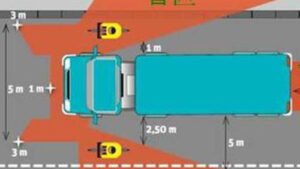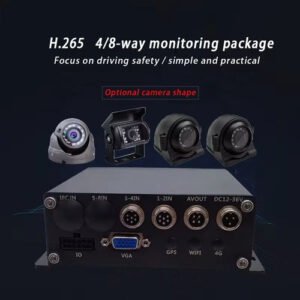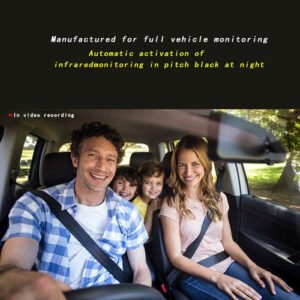A vehicle camera system is
In this article, we will explore the features, applications, and benefits of vehicle camera systems, alongside tips for choosing the right system for your needs.
1. What is a Vehicle Camera System?
A vehicle camera system is a network of cameras installed in and around a vehicle to capture real-time footage. These systems can include dashboard cameras, rear-view cameras, interior cameras, and side cameras.
They serve multiple purposes, such as monitoring driving behavior, recording incidents, providing evidence in accidents, and assisting with navigation. Modern systems often come with advanced features like GPS tracking, AI-powered analytics, and cloud storage for remote access to footage.
2. Why Do You Need a Vehicle Camera System?
Vehicle camera systems are more than just recording devices; they offer a wide range of benefits that improve safety, efficiency, and peace of mind:
2.1 Accident Documentation
- Capture real-time evidence of collisions to resolve disputes with insurers or authorities.
- Protect against false claims and staged accidents.
2.2 Fleet Management
- Monitor driver behavior and performance in real-time to ensure compliance with safety protocols.
- Optimize routes and improve operational efficiency.
2.3 Enhanced Safety
- Detect blind spots and assist with lane changes or reversing to prevent accidents.
- Track driver fatigue or distractions with advanced AI features.
2.4 Vandalism and Theft Protection
- Parking mode and 360-degree cameras safeguard vehicles against theft or damage when parked.
2.5 Regulatory Compliance
- Ensure adherence to road safety laws and industry regulations by maintaining video records of trips.
3. Applications of Vehicle Camera Systems
3.1 Commercial Fleets
Fleet operators use vehicle camera systems to:
- Monitor large fleets in logistics, delivery, and transportation industries.
- Reduce costs related to accidents, fuel usage, and maintenance.
3.2 Personal Vehicles
Individual car owners benefit from:
- Enhanced security with dash cameras and rear-view monitoring.
- Recording road trips and scenic drives.
3.3 Public Transportation
Buses, taxis, and rideshare services leverage vehicle camera systems to:
- Ensure passenger safety by monitoring in-vehicle activity.
- Document incidents involving passengers or pedestrians.
3.4 Emergency Services
Ambulances, police cars, and fire trucks use these systems for:
- Real-time situational awareness and evidence collection.
- Assisting in legal investigations.
4. Key Features of a Vehicle Camera System
To choose the right system, it’s essential to understand its core features:
4.1 Multi-Camera Setup
- Front Camera: Records the road ahead and captures oncoming traffic.
- Rear Camera: Assists with parking and records activity behind the vehicle.
- Interior Camera: Monitors passengers or cargo.
- Side Cameras: Eliminate blind spots, which is crucial for larger vehicles like trucks.
4.2 High-Definition Video
- Crisp footage with resolutions up to 4K ensures every detail is captured, including license plates and road signs.
4.3 Night Vision
- Infrared or low-light technology provides clear recordings even in complete darkness.
4.4 GPS Tracking
- Tracks vehicle location, speed, and route history, adding valuable data for fleet management.
4.5 AI-Powered Analytics
- Features like collision detection, driver fatigue monitoring, and lane departure warnings enhance safety.
4.6 Real-Time Alerts
- Sends notifications for unusual events like sudden braking, speeding, or collisions.
4.7 Cloud Storage
- Offers remote access to footage and ensures data is backed up securely.
4.8 Parking Mode
- Activates cameras when motion or impact is detected, protecting against vandalism and hit-and-runs.
5. Benefits of Using a Vehicle Camera System
5.1 Reduced Liability
Accurate footage helps protect drivers and companies against false claims and legal disputes.
5.2 Improved Driver Behavior
Monitoring systems encourage responsible driving, reducing accidents and promoting road safety.
5.3 Operational Efficiency
Fleet managers can optimize routes, monitor fuel consumption, and reduce idle time with data from the system.
5.4 Cost Savings
Preventing accidents, reducing wear and tear, and combating fraud contribute to lower operational costs.
5.5 Peace of Mind
Knowing your vehicle is continuously monitored ensures confidence whether you’re on the road or parked.
6. How to Choose the Best Vehicle Camera System
6.1 Assess Your Needs
Determine whether you need a basic dashcam for personal use or an advanced system for commercial fleets.
6.2 Video Quality
Choose systems with at least 1080p resolution for clear and reliable footage.
6.3 Number of Cameras
For comprehensive coverage, consider multi-camera systems, especially for larger vehicles.
6.4 Advanced Features
Evaluate features like GPS tracking, night vision, and AI-based alerts to match your specific requirements.
6.5 Storage Options
Ensure sufficient storage capacity, either through SD cards or cloud storage, to handle long recording periods.
6.6 Brand Reputation
Opt for systems from trusted manufacturers with positive reviews and reliable customer support.
7. Future Trends in Vehicle Camera Systems
7.1 AI Integration
Artificial Intelligence is transforming vehicle camera systems with features like real-time hazard detection and predictive analytics.
7.2 IoT Connectivity
Connected vehicle camera systems integrate with the Internet of Things (IoT) to provide seamless communication between vehicles, devices, and operators.
7.3 Advanced Driver Assistance Systems (ADAS)
ADAS features, such as adaptive cruise control and collision warnings, are increasingly being integrated into vehicle camera systems.
7.4 Autonomous Driving Support
Camera systems are vital for the development and functionality of autonomous vehicles, providing critical data for navigation and safety.
7.5 Eco-Friendly Monitoring
Future systems may focus on tracking and optimizing driving patterns to reduce emissions and fuel consumption.
8. Common Challenges and Solutions
8.1 Installation Issues
- Challenge: Improper installation can reduce the system’s effectiveness.
- Solution: Hire a professional installer or follow detailed instructions.
8.2 Data Management
- Challenge: Managing large volumes of footage can be overwhelming.
- Solution: Use systems with cloud storage or automated data overwriting.
8.3 Heat Resistance
- Challenge: High temperatures can damage equipment in hot climates.
- Solution: Choose systems with heat-resistant components.
8.4 Privacy Concerns
- Challenge: Some passengers or employees may feel uncomfortable with in-vehicle monitoring.
- Solution: Clearly communicate the purpose of the system and ensure compliance with privacy laws.
9. Conclusion
A vehicle camera system is an invaluable tool for enhancing safety, improving accountability, and reducing costs. Whether for personal use or managing a fleet, these systems provide comprehensive monitoring solutions that cater to modern driving needs.
With advancements in AI and IoT, vehicle camera systems are set to play an even more significant role in transforming how we drive and manage vehicles. Investing in the right system can future-proof your operations and ensure safer journeys for everyone.






